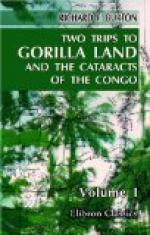Concerning the temper of these little captives, there are heroic differences of opinion. Mr. Ford records the “implacable desperation” of a juvenile which was brought to the Mission. It was taken very young, and kept four months, and many means were used to tame it; but it was so incorrigible, that it bit me an hour before it died.” Yet, in face of this and other evidence, Mr. W. Winwood Reade, writing to the “Athenaeum” (September 7, 1862), asserts that “the young gorilla in captivity is not savage.” “Joe Gorilla,” M. du Chaillu’s brat, was notoriously fierce and unmanageable. The Rev. Mr. Walker, of Baraka, had a specimen, which he describes as a very tractable pupil; and my excellent friend Major Noeliy White, better known as “Governor White,” of Corisco Island, brought to Fernando Po a baby Njina, which in its ways and manners much resembled an old woman. Mr. R. B. N. Walker became the happy godfather of two youngsters, who were different in disposition as Valentine and Orson. One, which measured 18 inches high, and died in 1861, was so savage and morose, that it was always kept chained; the other, “Seraphino,” was of angelic nature, a general favourite at the Factory: it survives, in a photograph taken by the French Commandant of the Comptoir, as it sat after breakfast on godpapa’s lap. At first it was confined, but it soon became so tame and playful, that the cage was required only at night. It never bit, unless when teased, and its only fault was not being able to avoid the temptation of eating what disagreed with it—in fact, it was sub-human in some points, and very human in others. All died in direct consequence of dysentery, which even a milk diet could not prevent. Perhaps the best way to send home so delicate an animal would be to keep it for a time in its native forest; to accustom it to boiled plantains, rice, and messes of grain; and to ship it during the fine season, having previously fitted up a cabin near the engine-room, where the mercury should never fall below 70 deg.(Fahr.). In order to escape nostalgia and melancholy, which are sure to be fatal, the emigrant should be valeted by a faithful and attached native.
The habitat of the gorilla has been unduly limited to the left banks of the Gaboon and Fernao Vaz rivers, and to the lands lying between north latitude 2deg., and south latitude 2deg.,—in fact, to the immediate vicinity of the equator. The late Count Lavradio informed me that he had heard of it on the banks of the lower Congo River (south latitude 9deg.), and the “Soko,” which Dr. Livingstone identifies with the Gorilla, extends to the Lualaba or Upper Congo, in the regions immediately west of the Tanganyika Lake. His friends have suggested that the “Soko” might have been a chimpanzee, but the old traveller was, methinks, far above making the mistake. The Yorubans at once recognize the picture; they call the anthropoid “Naki;” and they declare that, when it seizes a man, it tears the fingers asunder. So M. du Chaillu (chapter




